Understanding Christian Symbols to Enhance Your Exploring
Table of Contents
It’s exciting to venture out into new places, countries, continents, and cultures. Often times we come across Christian symbols as well as other religious symbols we may have never seen before, and as you travel the world, it’s essential to appreciate the cultural and religious significance attached to different symbols and icons, especially in countries with deep religious roots.
Exploring the crosses and symbols of the Christian religion can serve many purposes, such as showing respect for the country you’re visiting. Understanding these symbols can also enrich your experience and prevent unintentional offence to the locals.
Here are just a few examples of these symbols and icons.
The Latin Cross
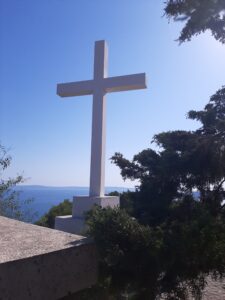
The Latin cross holds profound meaning within Christianity as it symbolizes the crucifixion of Jesus Christ, a pivotal event described in the New Testament. According to biblical accounts, Jesus willingly bore the weight of humanity’s sins on a cross, offering redemption and embodying themes of sacrifice, forgiveness, and unconditional love.
Typically constructed with two intersecting pieces of wood forming four right angles, the Latin cross is believed to resemble the structure upon which Jesus was crucified. It is embraced by various Christian denominations and commonly displayed on churches, grave markers, and religious artifacts.
Also known as the crux immissa, the Latin cross is a universally recognized religious symbol and occupies a central place in Western Christianity. Its design features two intersecting lines, with the vertical line being longer than the horizontal. This particular form of the cross is deeply entrenched in Christian traditions.
The origins of the Latin cross can be traced back to the Roman Empire, where it initially served as an instrument of punishment for criminals. Additionally, the cross symbolized Roman territorial claims and victorious military conquests.
Within Christian contexts, the Latin cross is widely employed in religious artwork, architectural elements, and jewelry. It holds significant importance in religious ceremonies, often invoked through the act of making the sign of the cross during prayer. As a symbol of hope and faith, the cross serves as a constant reminder to believers of Jesus’ selfless sacrifice.
Beyond its religious connotations, the Latin cross has permeated secular domains. It is used as a symbol of honor and bravery, frequently appearing on military medals and insignia. Furthermore, its incorporation as a decorative element in architecture and design adds symbolic depth and cultural heritage.
In Christian churches, the Latin cross often adorns the summits of buildings, acting as a visible representation of faith and worship.
The Greek Cross

The Greek Cross is another popular symbol of Christianity and is a symbol that is associated with the Eastern Orthodox Church. It is a cross with four arms of equal length which is a representation of the four evangelists: Matthew, Mark, Luke, and John. The four arms of the Greek Cross is also thought to represent the different persons of the Trinity. The Greek Cross is also associated with the idea of the resurrection, as the four arms are said to represent the four directions of the earth. It is The Greek cross is a symbol of the crucifixion of Jesus Christ, but it is also a symbol of the four evangelists: Matthew, Mark, Luke, and John.
The Greek cross, also known as the crux immissa quadrata, has a long history in both religious and artistic contexts. It is characterized by its arms of equal length, which are barely longer than the width. The cross has been especially used by the Eastern Orthodox Church and Early Christianity.
The Greek cross has its origins in ancient history. First, the church adopted the Latin Cross and Chi Rho through Constantine’s Labarum. Subsequently, Julian removed both. When Justinian then came to power, he returned to using the cross but began using what is known as the Greek Cross. The Greek Cross is notable because all four arms are of equal length, which is not the case with the Latin Cross.
The Greek Cross is a symbol of the Christian faith and is often used in religious art and architecture. It is also used as a decorative element in jewelry and other items. In the Eastern Orthodox Church, the Greek Cross is often used on the vestments of bishops and other clergy members. It is also used in the design of church buildings, where it is often incorporated into the floor plan.
One of the most famous examples of the use of the Greek Cross in architecture is the Hagia Sophia in Istanbul, Turkey. This building was originally built as a Christian church in the 6th century and later converted into a mosque. It features a massive dome that is supported by four piers, with each pier topped by a Greek Cross. This design element is one of the most striking features of the building and has been imitated in other buildings around the world.
Overall, the Greek Cross is an important symbol in the Christian faith and has a long and rich history in both religious and artistic contexts. Its use in architecture and design has made it one of the most recognizable symbols of the Christian faith.
The Celtic Cross
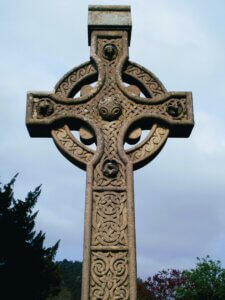
The Celtic Cross symbolizes a fascinating fusion of Christianity and Celtic heritage. Primarily associated with the Celtic people of Ireland and Scotland, this unique symbol features a cross with a circle encompassing the intersection of its arms. Adorned with intricate knots and patterns, the Celtic Cross originated in 5th-century Ireland and played a significant role in the spread of Christianity across the British Isles. Moreover, the symbol is closely linked to the concept of the Holy Trinity, with the three points of the cross representing the Father, Son, and Holy Spirit. It further embodies the unity between God and the universe, underscoring the interconnectedness of all things.
The Celtic cross is a symbol of the Christian faith, but it also has roots in pagan religions. The Celtic Cross is a symbol with a rich history and multiple meanings. It has been used by both Christians and Celts for religious and cultural purposes. The circle that surrounds the cross represents the sun, which was an important symbol in pagan religions. The Celtic cross is often used as a gravestone marker in Celtic countries. The Celtic Cross originated in Ireland during the early Middle Ages, sometime between the 6th and 9th centuries. It is believed to have been created by early Irish Christians who combined the traditional Christian cross with the pagan sun cross, which was a symbol of the Celtic religion. The sun cross was a circle with a cross inside, and it represented the four seasons and the four elements. The cross was used by the early Irish Christians to spread the message of Christianity throughout Ireland. The symbol was often used on stone crosses, which were placed at important sites, such as monasteries and churches. The crosses were also used to mark graves and to commemorate important events.The Celtic Cross has a number of different meanings and interpretations. For Christians, the cross represents the crucifixion of Jesus Christ and his sacrifice for humanity. The circle around the intersection of the arms and stem represents the eternal nature of God and his love for us. The circle around the intersection of the arms and stem represented the sun, which was an important symbol in Celtic religion. The circle also represented the cycle of life, death, and rebirth. The Celtic Cross is also a symbol of Irish identity and heritage. It is often used in art, jewelry, and other decorative items. The symbol has become so closely associated with Ireland that it is often called the Irish Cross. The symbol represents the crucifixion of Jesus Christ, the eternal nature of God, and the cycle of life, death, and rebirth. It is also a symbol of Irish identity and heritage. The Celtic Cross continues to be an important symbol in the modern world, and it is often used in art, jewelry, and other decorative items.
The Jerusalem Cross
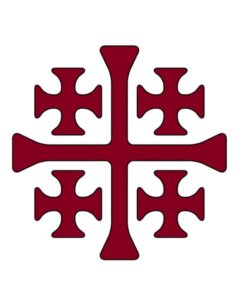
The Jerusalem Cross, also known as the Crusader’s Cross, is a symbol that has been used for centuries with a rich history and meaning. The Jerusalem Cross is a symbol that has been associated with the city of Jerusalem and originated during the Crusades in the 11th century. The four smaller crosses represent the four gospels of Matthew, Mark, Luke, and John. The four crosses also are believed to represent the four corners of the earth, in which Jesus desired His word to be proclaimed by His disciples. The large central cross is thought to represent the wound on Jesus’ side from which blood and water flowed after his crucifixion. Some believe the five crosses of the symbol represent the five wounds of Christ. The Jerusalem Cross has been used by various groups throughout history. The Crusaders used it as a symbol of their conquests in the Holy Land, while the Knights Hospitaller used it as a symbol of their service to the sick and poor.
Overall, the Jerusalem Cross is a powerful symbol of Christian faith and devotion whose rich history and various interpretations make it a fascinating symbol to study and explore. It is often used in Christian art, and is a unique symbol of the Christian faith.
The Knights Templar Cross
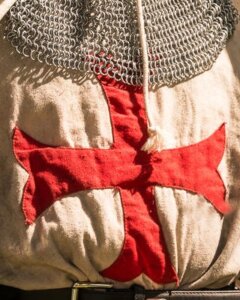
The Knights Templar Cross is a powerful symbol that has captured the imagination of people for centuries. The cross is shaped like a Latin cross with arms that flare outwards at the ends, and it has a distinctive red color. The Knights Templar played an important role in the history of the Crusades and were involved in battles in the Holy Land. The Templar Cross has a rich history that dates back to the medieval era, and it has come to symbolize many things, including courage, loyalty, and devotion. The cross is a reminder of the sacrifices made by the Knights Templar, who were known for their bravery and selflessness. Today, the Knights Templar Cross continues to fascinate and inspire people around the world, and its timeless appeal is a testament to the enduring power of symbols and the human spirit.
The Tau Cross
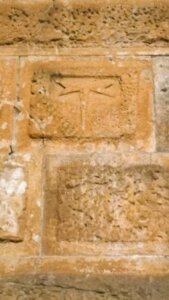
The Tau is named after the Greek letter “tau,” which is shaped like a T. It is one of the earliest Christian symbols that has been used for centuries. The name “tau” comes from the Greek letter tau, which looks like the Latin letter T. The symbol is also associated with the Hebrew letter tav, which is the last letter of the Hebrew alphabet and is believed to represent the final redemption of the world, and it is believed to have originated from the ancient Egyptian hieroglyph for life. The Tau Cross is also believed to have symbolic meaning, and is often associated with the sign of the cross, which is made by tracing the shape of the Tau Cross on the body.
The Tau ~ Saint Francis and Saint Anthony
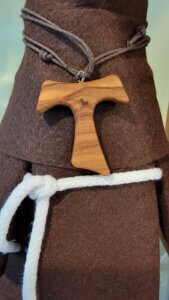
It is often associated with the Franciscan Order, Saint Francis of Assisi who used the Tau as his signature, his personal symbol, and of his commitment to simplicity, humility, and to a life of poverty and simplicity. He wore the symbol on his habit and encouraged his followers to do the same.
The Tau is also known as Saint Anthony’s Cross, that has also been associated with St. Anthony of Egypt, who was a hermit and a monk. He is considered the father of Christian monasticism, and he is known for his austere lifestyle and his dedication to prayer and contemplation. St. Anthony is said to have carried a Tau cross with him wherever he went. He is often depicted holding a Tau Cross in his hand as a symbol of his devotion to Christ and his commitment to a life of humility.
In addition to its use by Saint Francis and Saint Anthony, the Tau Cross has been used by various other Christian groups throughout history. It has been associated with the Knights Templar, who used the symbol on their shields and banners.
The Knights Templar and the Order of Tau
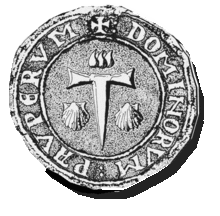
The Knights of the Tau, also known as the Order of Saint James of Altopascio or the Hospitallers of Saint James, were a religious military order founded in 1070 by Matilda of Tuscany. They were one of the earliest experiments with religious military orders and their mission was to enforce peace and care for the sick. The order operated hospitals throughout Italy and was composed of both knights and non-knight members. They were known for their distinctive black cloaks embroidered with the symbol of the Tau, which has various biblical meanings. The Knights of the Tau played an important role in protecting pilgrims traveling to the Holy Land and were involved in battles in the Holy Land during the Crusades. They were also known for their role in caring for the sick and their legacy lives on today as a testament to the power of selflessness and the enduring impact that a small group of dedicated individuals can have on the world.
The Ichthys
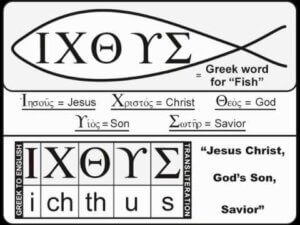
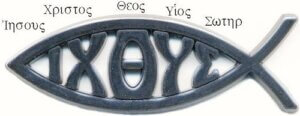
The Ichthys, also known as the Christian fish symbol, has a rich history and profound meaning within Christianity. This symbol, consisting of two intersecting arcs resembling the profile of a fish, is believed to have originated from the Greek word for fish, “ichthys/ichthus.” And while it may seem like a simple design, the Ichthys holds great significance for believers and non-believers alike. The fish is adorned with the letters “I-X-O-Y-E,” which stands for “Jesus Christ, Son of God, Savior” – what a powerful message!
According to biblical accounts, fish were a common food source in the region where Jesus lived and preached. And in the New Testament, Jesus is said to have miraculously fed a crowd of thousands with just a few loaves of bread and a few fish. This event, known as the Feeding of the 5,000, is believed to have inspired the use of fish as a symbol of faith and abundance.
But the Ichthys is more than just a symbol of food and abundance – it’s also a symbol of Jesus Christ himself. In the early days of Christianity, when it was still a persecuted and underground religion, the Ichthys served as a secret code for believers to identify one another. The Greek word for fish, “ichthys/ichthus,” was also used as an acronym for “Iesous Christos Theou Yios Soter,” which translates to “Jesus Christ, Son of God, Savior.” This symbol served as a way for early Christians to communicate their faith without fear of persecution. And over time, the Ichthys became a widely recognized symbol of Christianity, appearing on everything from churches and religious artifacts to jewelry and clothing.
But the Ichthys isn’t just a symbol of faith – it’s also a symbol of love and community. In the early days of Christianity, believers would use the Ichthys to mark meeting places and safe houses, creating a sense of community and belonging. And even today, the Ichthys serves as a reminder of the power of faith and the importance of coming together as a community. it’s also a popular design element in fashion and home decor, and while some may argue that this dilutes the religious significance of the symbol, others see it as a way to spread the message of faith and love to a wider audience.
The Amkh
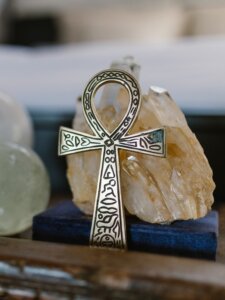 The Ankh, an ancient Egyptian symbol predating Christianity, has found a home in the Coptic Christian Orthodox Church originating in Egypt. To Coptic Christians, the Ankh holds deep significance as a representation of Christ’s resurrection and eternal life, often referred to as a crux ansata, meaning “cross with a handle,” in Latin.
The Ankh, an ancient Egyptian symbol predating Christianity, has found a home in the Coptic Christian Orthodox Church originating in Egypt. To Coptic Christians, the Ankh holds deep significance as a representation of Christ’s resurrection and eternal life, often referred to as a crux ansata, meaning “cross with a handle,” in Latin.
The Ankh manifests as a cross with a loop at the top, occasionally adorned with symbols or decorative embellishments, yet typically presented as a simple gold cross. It serves as a symbol of everlasting life, while within the Coptic Christian faith, it also embodies the Holy Trinity. The loop symbolizes the Father, the crossbar signifies the Son, and the base represents the Holy Spirit. In Christian art, angels are often portrayed holding the Ankh, symbolizing the concept of eternal life in heaven.
While the Ankh has been embraced by the Christian faith, it remains one of the most recognizable symbols from ancient Egypt. Known as “the key of life” or “cross of life,” it traces its origins back to the Early Dynastic Period (c. 3150 – 2613 BCE). Symbolizing life and immortality, the loop of the Ankh signifies eternal life, while the cross denotes the physical world.
Throughout history, the Ankh has been subject to various interpretations. Some view it as the sun descending below the horizon, while others perceive it as a union of masculine and feminine energies. Additionally, it represents eternal life, fertility, and the power of the Nile River.
In ancient Egypt, both gods and mortals utilized the Ankh symbol. It frequently appeared in the hands of gods such as Osiris, the deity associated with the afterlife and resurrection. Pharaohs also embraced the Ankh, believing it would grant them eternal life. Consequently, many pharaohs were interred with an Ankh in their tombs. Its enduring popularity and profound significance make it a symbol worthy of exploration and comprehension.
Overall, the Ankh symbol encapsulates a vast history and multifaceted meanings. It serves as a potent emblem of life, fertility, and resurrection, resonating across millennia of human existence.
The Chi Rho
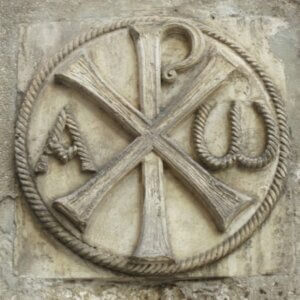
The Chi Rho is a symbol that is made up of the first two letters of the Greek word for Christ, it is formed by superimposing the first two letters of the Greek word for Christ, “ΧΡΙΣΤΟΣ,” which are “Chi (X)” and “Rho (P).” The symbol has been used by Christians for centuries and is still used today to represent Jesus Christ and Christianity. The Chi Rho is often associated with the idea of the crucifixion, as it is said to represent the nails that were used to crucify Jesus. Some interpretations of the Chi Rho symbol suggest that the “X” represents the cross on which Jesus was crucified, while the “P” represents the spear that was used to pierce his side. Others suggest that the “X” and “P” represent the first two letters of the Greek word for “fish,” which was a symbol used by early Christians to identify themselves to one another.
The first public use of the Chi Rho symbol was on the labarum, the shield of Constantine’s warriors in the Battle of Milvian Bridge on October 28, 312 AD. Constantine I, the Roman Emperor, is said to have seen a vision of the Chi Rho symbol in the sky before the battle, along with the words, “In this sign, you shall conquer.” After his victory, Constantine adopted the symbol as his own and used it on his coins and other official documents.
The Chi Rho symbol has also been used in Christian art and architecture. It can be found in frescoes, mosaics, and stained glass windows in churches and cathedrals throughout the world. The symbol is often used in combination with other Christian symbols, such as the cross, to represent different aspects of Christianity.
Regardless of its exact meaning, the Chi Rho symbol remains an important symbol of Christianity and is recognized by Christians and non-Christians alike. It is a symbol of faith, hope, and love, and serves as a reminder of the sacrifice that Jesus made for humanity.
I always enjoy learning new things about places and cultures. Understanding symbols and the local culture and history shows respect and sensitivity towards the customs of the country we’re visiting. We create a more positive and meaningful travel, and let’s be real, who doesn’t want to have an amazing time while traveling? Comprehending religious symbols is a fundamental aspect of cultural sensitivity and significantly enriches the travel experience by fostering a deeper understanding of the local culture and history. By demonstrating respect and sensitivity towards the customs of the visited country, travelers create a more positive and meaningful travel encounter.


